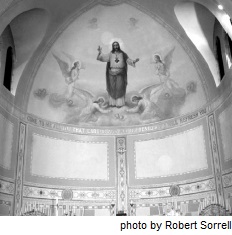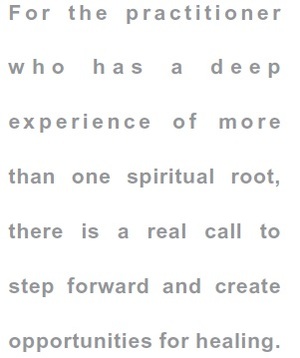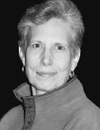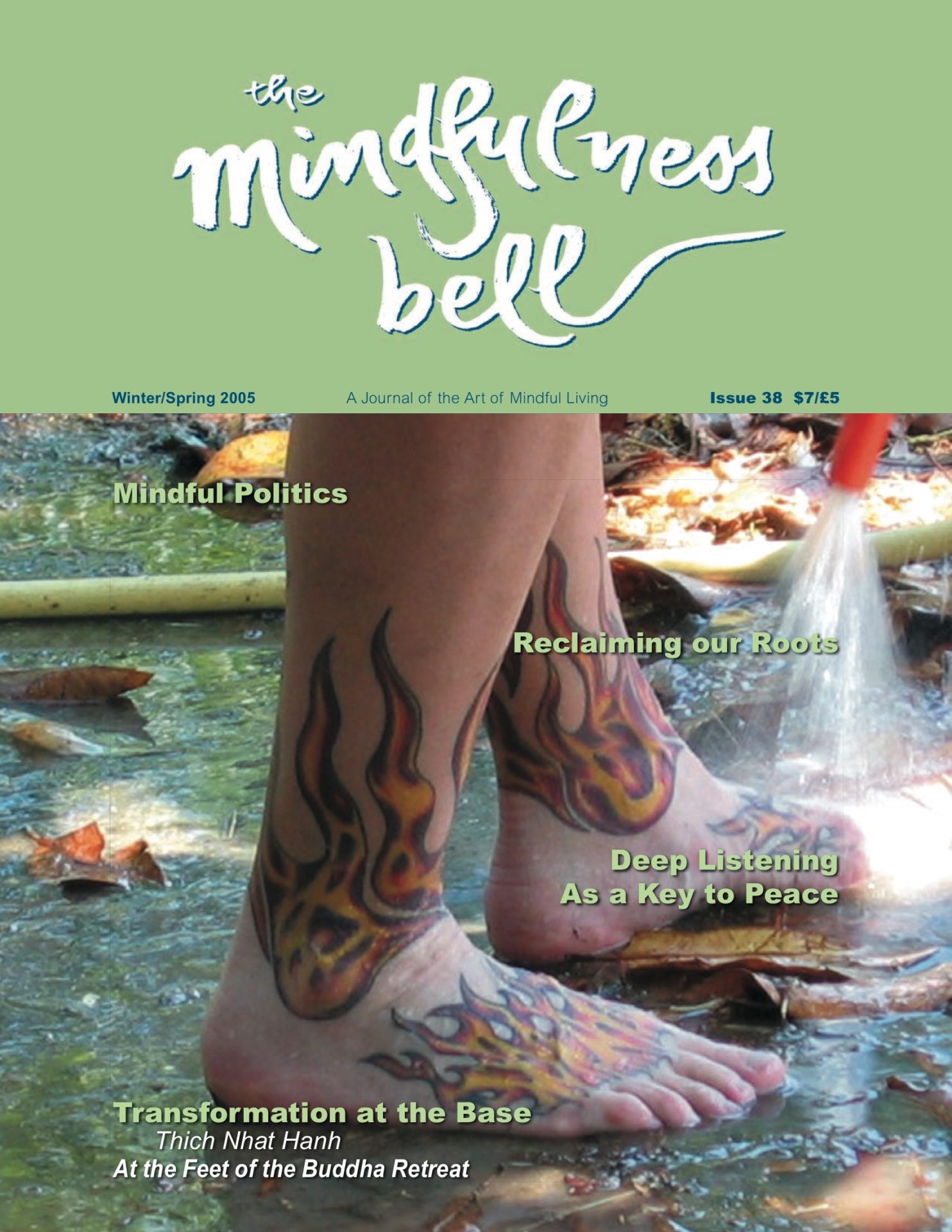By Starr DiCiurcio
Aware of the suffering created by attachment to views and wrong perceptions, we are determined to avoid being narrow-minded and bound to present views. We shall learn and practice nonattachment from views in order to be open to others’ insights and experiences. We are aware that the knowledge we presently possess is not changeless, absolute truth. Truth is found in life, and we will observe life within and around us in every moment,
By Starr DiCiurcio
Aware of the suffering created by attachment to views and wrong perceptions, we are determined to avoid being narrow-minded and bound to present views. We shall learn and practice nonattachment from views in order to be open to others’ insights and experiences. We are aware that the knowledge we presently possess is not changeless, absolute truth. Truth is found in life, and we will observe life within and around us in every moment, ready to learn throughout our lives.— From The Fourteen Mindfulness Trainings

Recently I was sitting in an old Catholic church for the funeral of a dear friend’s father. The massive stone building reminded me of the church I attended every Sunday as a child. Memories came up from the familiar smells of incense, candle wax, and dampness. I began reflecting on the intertwined relationships of religious institutions, the larger experience of spirituality, and culture. I am an American Buddhist, a member of the Order of Interbeing. I am also a Christian. The first fifty years of my life were spent as a Catholic, if not always a happy one. There was a certain discomfort with the institutional church that came early in my life, leaving me feeling such a lack of identity with the community that participation became rote and empty. In Buddhism, I have found the spiritual home that I had lost in Catholicism, but I do not reject that great wisdom tradition that formed so much of my spiritual life. Many parts of the church might reject me today, but I do not feel any impulse to reject in turn.
As I sat sharing my friend’s grief, I thought about all I had learned as a teacher of English as a second language to students transitioning to America. I repeatedly told them to value their homelands, their roots, their heritages. Now I was telling myself the same thing. There is no need for me to dismiss the great teachings and beauty of the Church of my youth in order to embrace my new spiritual life.
My Real Jesus
Jesus is real to me, but the Jesus I love is not the one many others profess to follow. I love the Jesus whom I understand to be Buddha’s brother—full of compassion and all inclusive in his reaching out in love to the world. He is not the Jesus known to some as a judge, a strict interpreter of right and wrong. Nor would he condone his followers becoming judges of others in his name. It does not matter to me whether Jesus rose from the dead in a physical sense; whether he was immaculately conceived; or whether he walked on water. It does matter to me that he gave the Sermon on the Mount to help inform my life, and that he reached out to everyone around him, even the lowest of the low. The Jesus I know was a great reformer who came from the fringes of society. He prayed in solitude before performing his public work. He was alone, and he was also in community. This Jesus called on all his followers to live lives of lovingkindness, above all else.
In the quiet of the church the vibrant jewel tones of the stained glass windows shone even on that gray, rainy morning. I looked at the old statues around the sanctuary that some artisan lovingly and with great devotion sculpted. I felt unmoved. But as the elderly priest came in and prepared the altar, compassion arose in me. This is not an easy time to be a priest. Certainly over the years this man has witnessed many of his contemporaries’ departures from the priesthood, through choice, accusation of misconduct, and death. Few young men have joined these communities and the priests who are left in the ministry commonly experience declining respect and great loneliness. As he genuflected before the altar and put flowers in a vase before the Blessed Virgin, I remembered that in my youth a priest would never have performed this simple task of flower arranging. Where are all the ladies of the Altar Society? They are part of a lost culture.
Embracing the Gifts of My Root Faith

This faith of my youth is an encompassing culture that has defined much of me: my sensitivities, my values, and my spiritual awareness. It has brought its great history and scope to my days and, in turn, I have given back through devotion, study, and teaching. This is the faith experience of my early childhood when I knelt at Mass alongside my rosary fingering, Irish father who was one of the most faith-filled people I have ever known. This is the faith experience that rejected my mother’s belief system – also Christian but of another church. This is the faith experience of my college life and studies, and also the faith experience that guided my teaching of theology. This is the faith experience I have passed on to my children who came to us through Mother Teresa. We know nothing of their birth parents except that they chose to leave their children with the sisters, and that is a connection full of meaning and import that we, as a family, continue to honor.
This Catholic Church has all the earmarks of culture––art forms, language, rituals, and belief systems. Gregorian chants can lift me emotionally and spiritually and remind me of robing with my college classmates to sing Benediction every Thursday. Their Latin brings back my earliest profound experiences of prayer. The structures of European cathedrals inspire and call to mind spiritual ancestors who labored to place stone upon stone until they erected something far greater than the sum of each daily effort. Entering many churches, old or modern, grand or modest, can be conducive to reflection, meditation, prayer, and spiritual opening. As a mother, during rough times I have always found comfort in contemplating Mary and her extraordinary experience of motherhood. I also take refuge in Avalokiteshvara, but Mary holds a special place in my heart since she was a mother figure for me through my formative years. It is interesting that statues of Mary and Avalokiteshvara have been used interchangeably in times of persecution of Asian Buddhists and Catholics. Shouldn’t that teach us all something?
For those of us coming to Buddhism later in life, it can be refreshing and nourishing to reflect upon the earlier lessons of our spiritual lives. As we open our hearts and minds to the past, we create a wholeness within that allows us to enter the present fully, with our entire being. This is an acknowledgment of the nonduality of existence that can be gleaned and nurtured within us as we mature. Being inclusive of the differences within ourselves is helpful as we try to be inclusive of differences in the larger contexts of our world. Our compassion as Buddhists is transcendent. It includes that which we have appeared to have left behind on our journey. It shows us ways to incorporate old practices we wish to retain with new practices we have come to love. Perhaps that is one of the richest opportunities for spiritual growth––embracing what in our past religious or spiritual practice has disappointed or wounded us, as well as what has enriched us. If anger is there, instead of pushing it down or away, we can embrace it and learn as we heal.
Practicing Interfaith Dialogue
Thay has taught us that the most basic principle of interfaith dialogue is that it must begin within ourselves. It may take time to look deeply at all the aspects of our spiritual histories and the institutions that have attempted to hold them. But like so much in life, it is the challenging nature of this quest that brings great fruit to the practitioner. If we understand the major wisdom traditions as dynamic and living entities, we realize that this is an ongoing process. Bringing the practices of deep looking and deep listening to interfaith experiences can lead to greater understanding and progress for peace. But first one needs to establish that understanding and peace within one’s own being.
Over the ages we have seen borders drawn, walls erected, families splintered and wars fought over religious differences. Over and over, we witness people claiming to know the best, or even the only true way to spiritual fulfillment. Misinformation, stereotyping, deep prejudice, intolerance—all abound. More than ever, the stake in these dangerous human games is the very existence of humankind. Our reasons for fighting are discouragingly unchanged over time, but the instruments of battle evolve in more and more far ranging and catastrophic ways.
A Call to Step Forward
For the practitioner who has a deep experience of more than one spiritual root, there is a real call to step forward and create opportunities for healing. It seems all too common in religions institutions to find extremists who are counterproductive to helping create a peaceful world of true brotherhood and sisterhood. Isn’t it wiser to look at all spiritual life as a mere glimpse of the Ground of Being, the Kingdom of God, the Pure Land? How blessed is the person who gets to really see through more than one of these lenses! And with that blessing comes a responsibility to use the enlightenment of the resultant understanding to help others come together—not just in tolerance, but in true appreciation of the great depth, beauty, and opportunity offered by each tradition.

Many spiritual leaders have understood this need for healing and have had keen appreciation of paths outside their own. What is desperately needed today is to take that understanding out of our individual spiritual lives and into religious institutions. Thay has modeled this brilliantly in his own life, and in the life of his community. The first several of the Fourteen Mindfulness Trainings are beacons of hope for the world. They call us to practice openness, truth, freedom, compassion, and understanding. They warn us against judgment, intolerance, rigidity, and self-righteousness. As we support one another in our Sanghas we can bring this healing to each other, our communities, and to the world; we can be peacemakers all, taught by the Buddha, his brother Jesus, and our other precious spiritual ancestors.

Starr DiCiurcio, True Understanding of the Sangha, lives in Schenectady, New York and practices with the Kingfisher Sangha.

